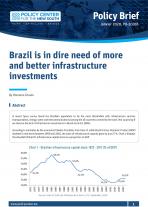Brazil is in dire need of more and better infrastructure investments
A recent Ipsos survey found the Brazilian population to be the most dissatisfied with infrastructure services (transportation, energy, water and telecommunications) among the 28 countries covered by the work. Not surprising if we observe the lack of infrastructure investments in Brazil since the 1980s. According to estimates by the economist Cláudio Frischtak, from Inter. B, while Brazil's Gross Domestic Product (GDP) doubled in real terms between 1990 and 2016, the stock of infrastructure capacity grew by just 27 %. Chart 1 displays the downfall of Brazil’s infrastructure capital stock as a proportion to GDP.
Figures from World Bank report (Raiser et al, 2017) point to infrastructure investments averaging over 5% of GDP between the 1920s and 1980s, a period in which per capita income grew at an annual rate average of 4% and urbanization reached levels of 60% in 1980. In the last two decades, however, the pace of investment has fallen to less than 2.5% of GDP, even below its maintenance needs (Chart 2, left side).
Brazil’s current inventory of physical infrastructure, relative to GDP, is smaller than most countries with comparable income levels. Although access to electricity and telecommunications has improved since the 1990s, basic sanitation and transportation networks are falling short of those of their peers - even when one considers the country’s relatively high territorial dispersion and low population density.










